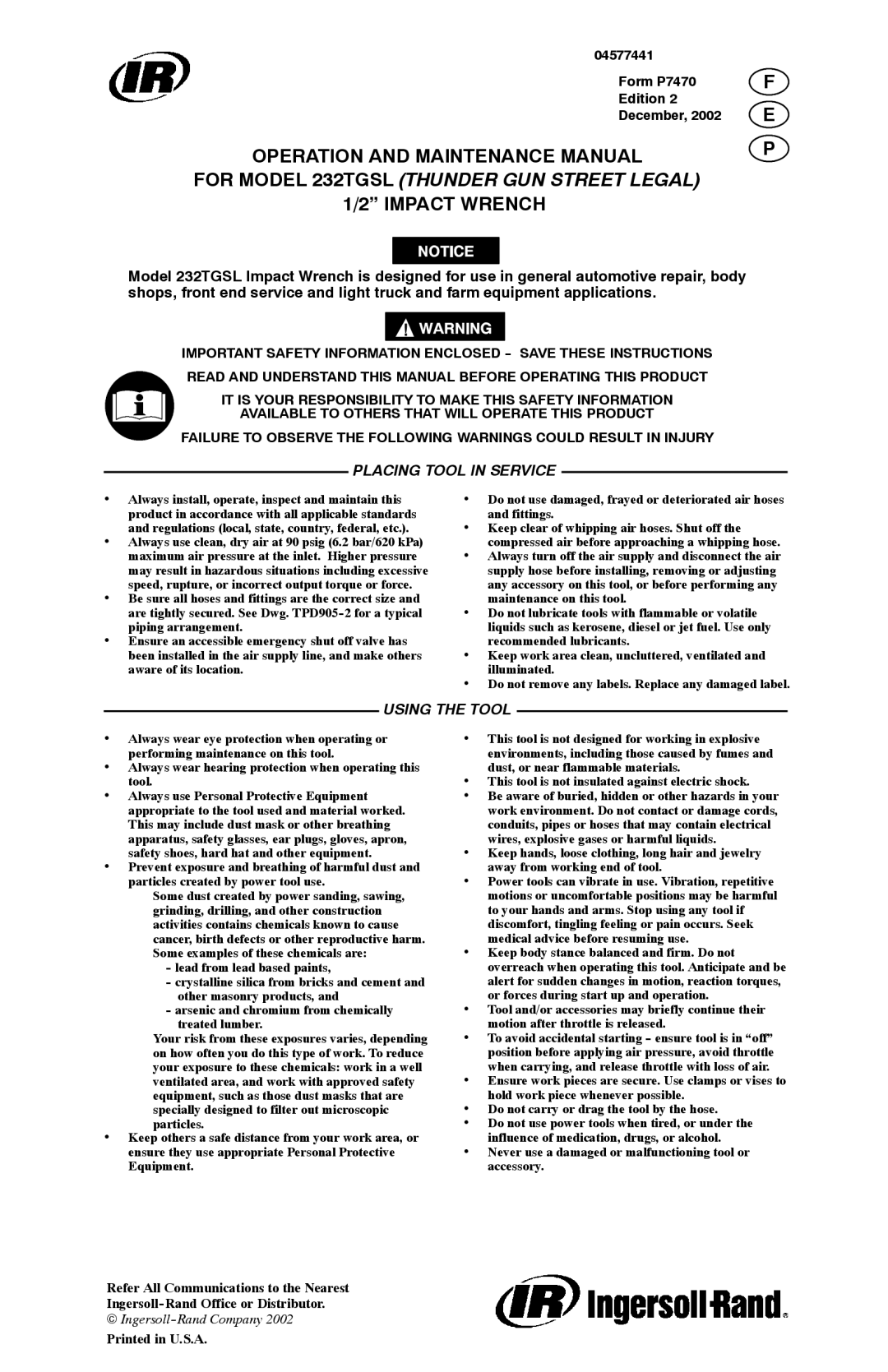
04577441 |
|
Form P7470 | F |
Edition 2 | E |
December, 2002 | |
OPERATION AND MAINTENANCE MANUAL | P |
| |
FOR MODEL 232TGSL (THUNDER GUN STREET LEGAL) |
|
1/2” IMPACT WRENCH |
|
Model 232TGSL Impact Wrench is designed for use in general automotive repair, body shops, front end service and light truck and farm equipment applications.
IMPORTANT SAFETY INFORMATION ENCLOSED
IT IS YOUR RESPONSIBILITY TO MAKE THIS SAFETY INFORMATION
AVAILABLE TO OTHERS THAT WILL OPERATE THIS PRODUCT
FAILURE TO OBSERVE THE FOLLOWING WARNINGS COULD RESULT IN INJURY
PLACING TOOL IN SERVICE
•Always install, operate, inspect and maintain this product in accordance with all applicable standards and regulations (local, state, country, federal, etc.).
•Always use clean, dry air at 90 psig (6.2 bar/620 kPa) maximum air pressure at the inlet. Higher pressure may result in hazardous situations including excessive speed, rupture, or incorrect output torque or force.
•Be sure all hoses and fittings are the correct size and are tightly secured. See Dwg.
•Ensure an accessible emergency shut off valve has been installed in the air supply line, and make others aware of its location.
•Do not use damaged, frayed or deteriorated air hoses and fittings.
•Keep clear of whipping air hoses. Shut off the compressed air before approaching a whipping hose.
•Always turn off the air supply and disconnect the air supply hose before installing, removing or adjusting any accessory on this tool, or before performing any maintenance on this tool.
•Do not lubricate tools with flammable or volatile liquids such as kerosene, diesel or jet fuel. Use only recommended lubricants.
•Keep work area clean, uncluttered, ventilated and illuminated.
•Do not remove any labels. Replace any damaged label.
USING THE TOOL
•Always wear eye protection when operating or performing maintenance on this tool.
•Always wear hearing protection when operating this tool.
•Always use Personal Protective Equipment appropriate to the tool used and material worked. This may include dust mask or other breathing apparatus, safety glasses, ear plugs, gloves, apron, safety shoes, hard hat and other equipment.
•Prevent exposure and breathing of harmful dust and particles created by power tool use.
Some dust created by power sanding, sawing, grinding, drilling, and other construction activities contains chemicals known to cause cancer, birth defects or other reproductive harm. Some examples of these chemicals are:
-lead from lead based paints,
-crystalline silica from bricks and cement and other masonry products, and
-arsenic and chromium from chemically treated lumber.
Your risk from these exposures varies, depending on how often you do this type of work. To reduce your exposure to these chemicals: work in a well ventilated area, and work with approved safety equipment, such as those dust masks that are specially designed to filter out microscopic particles.
•Keep others a safe distance from your work area, or ensure they use appropriate Personal Protective Equipment.
•This tool is not designed for working in explosive environments, including those caused by fumes and dust, or near flammable materials.
•This tool is not insulated against electric shock.
•Be aware of buried, hidden or other hazards in your work environment. Do not contact or damage cords, conduits, pipes or hoses that may contain electrical wires, explosive gases or harmful liquids.
•Keep hands, loose clothing, long hair and jewelry away from working end of tool.
•Power tools can vibrate in use. Vibration, repetitive motions or uncomfortable positions may be harmful to your hands and arms. Stop using any tool if discomfort, tingling feeling or pain occurs. Seek medical advice before resuming use.
•Keep body stance balanced and firm. Do not overreach when operating this tool. Anticipate and be alert for sudden changes in motion, reaction torques, or forces during start up and operation.
•Tool and/or accessories may briefly continue their motion after throttle is released.
•To avoid accidental starting - ensure tool is in “off” position before applying air pressure, avoid throttle when carrying, and release throttle with loss of air.
•Ensure work pieces are secure. Use clamps or vises to hold work piece whenever possible.
•Do not carry or drag the tool by the hose.
•Do not use power tools when tired, or under the influence of medication, drugs, or alcohol.
•Never use a damaged or malfunctioning tool or accessory.
Refer All Communications to the Nearest
Printed in U.S.A.
